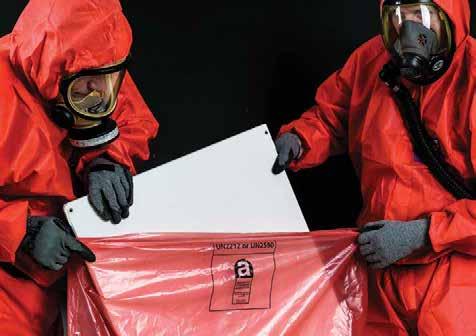
5 minute read
Managing asbestos
Clients have the legal responsibility to appoint competent asbestos removal contractors
Appoint - Plan - Remove
It is vital that property owners and managers – commercial properties, NHS, schools, housing groups - take the risks from asbestos seriously and deal with asbestos in a controlled and safe manner. Still today it is the greatest cause of work-related deaths in the UK, with currently approx. 5,000 asbestos related cancer deaths per year.
Owners and managers of properties
constructed prior to the year 2000 need to manage the risks from asbestos, as they are responsible for ensuring that employees and non-employees are not exposed to health and safety risks as a result of the presence of asbestos.
If asbestos containing materials (ACMs) are found within a building and the condition of the ACMs means it needs to be removed, or the building is being renovated/demolished so therefore the ACMs need to be removed prior to work starting, there are legal responsibilities on the clients to manage the project and appoint a competent contractor.
Client duty to manage a project
Clients have explicit responsibilities on managing construction projects under the Construction (Design and Management) Regulations 2015 (CDM 2015). As they are at the head of the procurement chain, the law requires that clients make suitable arrangements for managing a project, and maintain and review these arrangements throughout the project, to ensure health and safety risks are managed appropriately.
Clients do not need to be ‘experts’ in either construction work or asbestos work, and do not need to directly manage or supervise the work themselves. However, they are responsible for ensuring appropriate arrangements are in place to manage and organise projects during both the ‘pre-construction’ and ‘construction’ phases of the project. This means appointing suitably competent people and providing them with sufficient information, time and resources to do the job properly.
If asbestos removal is required, the client needs to appoint a competent asbestos removal contractor. Therefore, they need to make reasonable enquiries to satisfy themselves that contractors are appropriately resourced and competent for the work.
How can clients reassure themselves of competency?
Firstly, does the type of asbestos containing material require a contractor to have a licence from the Health & Safety Executive (HSE) to remove this material under controlled conditions? A list of licence holders is available on the HSE website.
Secondly, is the contractor independently audited, that is, undertakes on-site verification inspections to ensure compliance to requirements. How can a client check this?
One way to check is to see whether the contractor is a member of a trade association, as some clients expect a trade association to maintain industry standards and provide a safe guard.
Asbestos removal carries a high level of health and safety risks, so clients should look behind a trade association logo to see what reassurance that membership actually provides.
To provide reassurance for all parties of compliance with relevant legislation, ARCA introduced the Site Audit Accreditation Scheme (SAAS) in 2000, to support members’ performance and therefore maintain standards. ARCA member contractors are required to have a satisfactory site audit to join [and an office audit], and then two satisfactory site audits every year to maintain membership of the Association.
ARCA took a further step towards supporting consistent high standards and a higher level of reassurance, by enhancing its audit scheme in January 2017.
Members still need to complete two satisfactory site audits every year to maintain membership, however, these audits are now unannounced. This has been made possible by the HSE providing ARCA with some details [name of licensee, site location, dates of work and nature of work] off the licensed contractors ‘notification of asbestos work’ form.
Using this information ARCA can arrange site audits, so that ARCA members (excluding Ireland) have no

prior knowledge of when, or where, an ARCA auditor will be assessing their performance. Therefore, being unannounced, ARCA site audits are an even stronger system of reassurance for all parties, including clients.
From January 2020 ARCA and members commited to increasing the SAAS requirement from 2 to 3 unannounced site audits each membership year.
Asbestos removal work
Once a contractor is appointed, the client will then need to provide the contractor with sufficient information, time and resources to do the job properly. For example, an asbestos removal contractor will need appropriate preconstruction information in order to prepare a suitable Plan of Work, and contractors need time (and access) to assess the premises properly and discuss key site information with the client. Clients’ decisions, actions and inaction have an enormous impact on how work can be delivered. The contractor will need to submit notification of work to the HSE two weeks prior to work commencing. That is, the work must be planned before it starts.
A Plan of Work
It is the duty of the licensed asbestos removal contractor to produce a suitable Plan of Work (PoW) and comply with Regulation 7 of the Control of Asbestos Regulations 2012 (CAR 2012).
A PoW should be a practical and useful document describing the site, location of asbestos, access and waste routes, etc. so providing a safe working method for site staff to follow.
Also a PoW should be complete but manageable in length; for example the use of diagrams, photographs and flowcharts can all help make PoWs less wordy; and should be easy to read and straightforward to follow. This is supported by HSE, as their position is that generic information about frequently used company procedures (such as standard ways of bagging waste, standard enclosure construction materials etc) will not need to be in the site-specific plan. Keeping generic information out of the site-specific plan means the standard procedures on which it is based need to be available on-site in a readily accessible and readable format, be that electronic or hard copy.
The asbestos removal contractors’ manager should create the PoW with the client, so both parties are aware of any site constraints, other trades on-site, etc.
Finally, a PoW is there to primarily support site staff, but should also be available for the analyst, manager, auditor, HSE inspector and client.
Good coordination and cooperation between all parties is a must for a project to be successful.
Guidance for clients has been produced by ARCA and is available in the ‘clients’ section at www.arca.org.uk








